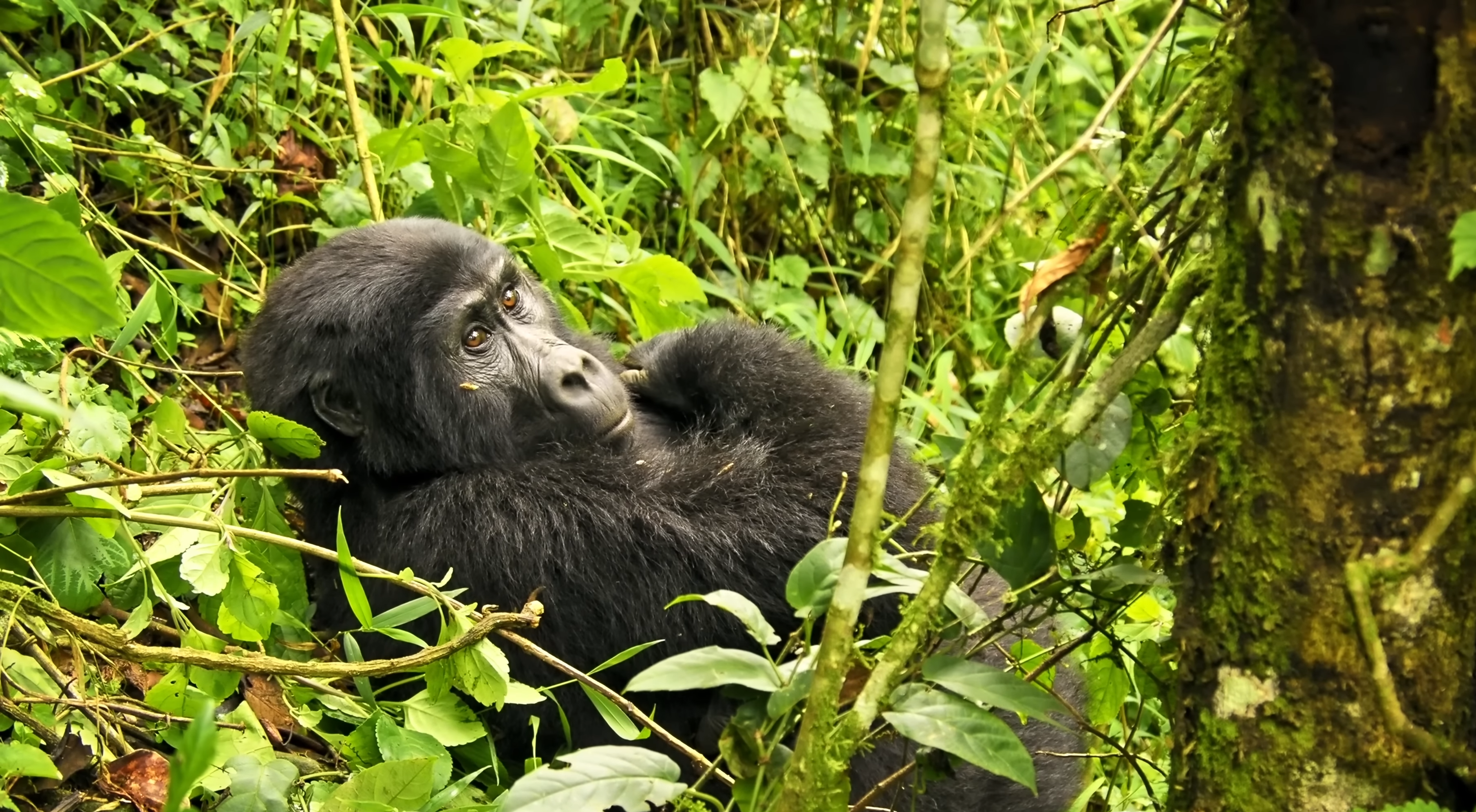Rwanda Gorilla Groups and Families Habituated in Volcanoes
The Volcanoes National Park in Rwanda is home to 10 gorilla groups and Families, totalling around 380 mountain gorillas. This national park is part of the Virunga mountain range, which extends into the Democratic Republic of Congo and is inhabited by approximately 500 mountain gorillas. The remaining mountain gorilla population resides in Uganda’s Bwindi Impenetrable Forest and Mgahinga Gorilla National Park.
Understanding Rwanda Gorilla Groups’ and Families’ Dynamics:
Mountain gorillas live in family groups led by a dominant silverback male. When tourists visit the park for gorilla tours, allocating gorilla families is based on various factors including visitor preferences, accommodation, and physical fitness levels. Rwanda has 10 habituated gorilla groups, each divided into those for research purposes and those open to tourists. Notably, the Shida and Beetsme groups are primarily for research and comprise the highest number of individuals.
Rwanda|Gorilla Trekking|Two Families|30+ Gorillas|Fighting
Similar to Uganda’s gorilla families, only eight visitors are allowed to visit each gorilla group per day, resulting in a maximum of 80 available gorilla permits for booking on any given day. Some of the groups live deep in the forest, requiring longer tracking hours and navigating difficult and steep terrain. These gorilla groups and families also move to different locations each day while building new nests for the night, adding to the challenge and excitement of tracking them.
In Rwanda, there are several habituated gorilla groups and families that are accessible for tourism and research
Susa Gorilla Group (Susa A Family)
The Susa Gorilla Group (Susa A Family) is particularly renowned due to its connection to zoologist Dian Fossey and her research activities. This group, located high in the mountains, is home to 28 members, including 3 silverbacks. The Susa group was originally composed of 42 members before a split occurred due to a feud. Notably, the playful young twins Byishimo and Impano, as well as one of the oldest habituated gorillas named Poppy, make this gorilla group a captivating and dynamic sight to behold. However, due to its challenging terrain and sometimes distant location, visiting the Susa Gorilla Group can take an entire day and may not always be accessible to tourists.
Karisimbi Gorilla Group (Susa-B)
The Volcanoes National Park in Rwanda is home to several gorilla groups, each with its distinctive characteristics and behaviours. One of the notable groups is the Karisimbi Gorilla Group (Susa-B), which split from Susa (Susa-A) and is known for its challenging tracking due to its location on the slopes of the Karisimbi volcano.
Sabyinyo Gorilla Group
The Sabyinyo Gorilla Group, led by the commanding silverback Guhonda, is a compact assemblage located in the proximity of the Sabyinyo Volcano. In contrast, the Amahoro Gorilla Group, under the leadership of Ubumbwe, is distinguished by its tranquil disposition, notwithstanding the adversities posed by another silverback, Charles.
Comprising about 8 members and under the leadership of the robust silverback Guhonda weighing approximately 220 kg, the group derives its eponym from the Sabyinyo “Old man’s teeth” Volcano, its habitat. Guhonda has maintained group cohesion by ostracizing and marginalizing his rival silverback, Ryango, consequently rendering him a solitary entity beyond the group’s periphery. The group encompasses lively juveniles and is readily observable due to their proximity to the park’s boundaries.
Agashya Gorilla Group
The social group, originally referred to as “Group 13” and under the leadership of Nyakarima, encountered a significant upheaval when Agashya initiated a lethal confrontation, subsequently usurping the entire family and leading them up the volcano. This seizure marked the first documented instance of such behaviour by gorilla researchers. Following this event, Agashya actively expanded the group by incorporating individuals from other groups and assimilating solitary gorillas, distancing themselves from Nyakarima. Situated proximate to the Sabyinyo gorilla group, Agashya has developed a predilection for leading the group to a preferred secure location atop the volcano at the first sign of peril, rendering the group challenging to monitor. Presently, the group has burgeoned from its initial 13 members to approximately 25 individuals.
Umubano Gorilla Group
Umubano, which means “living together“, was once part of the Amahoro family until Charles, the leader, decided to break away from the dominant silverback, Ubumbwe. As Charles grew older, he began to challenge the peaceful leadership of the Amahoro group. After numerous conflicts with Ubumbwe, Charles took some females from the Amahoro family and started his group. This gorilla family consists of 11 individuals, including 6 youngsters, and lives near the Amahoro family. Tourists often visit this group because they are relatively easy to reach and have a unique personality.
Amahoro Gorilla Group
The Amahoro gorilla family, led by the dominant silverback Ubumbwe, consists of 17 members and is known for its peaceful nature. Despite facing challenges from another silverback named Charles, Ubumbwe has maintained a calm and peaceful leadership style. The group lives on the slopes of Mount Visoke, requiring visitors to navigate steep terrain to visit. However, the group’s appeal lies in its calm demeanour, as well as the presence of juveniles, making it a favourite among visitors.
Kwitonda Gorilla Group
The Kwitonda Gorilla Group, which hails from Congo, inhabits the slopes of Mount Muhabura. Comprising 18 individuals, including two silverbacks, this group can be challenging to monitor. Led by Kwitonda, meaning “humble one” in Kinyarwanda, the group has its roots in gorilla communities in Congo. While the group predominantly dwells around the slopes of Mount Muhabura, they have a broad geographical range, which adds to the thrill and challenge of tracking them.
Hirwa Gorilla Group
The Hirwa Gorilla Group, a relatively new and unique gorilla group, was formed when individuals from Group 13 and the Sabyinyo family came together to create their family unit. This extraordinary group is led by a dominant and protective silverback and is situated on the slopes of Mount Sabyinyo. The name “Hirwa” translates to “lucky one” and reflects the good fortune of the group in attracting additional individuals voluntarily. This unconventional formation was observed in 2006, and the group currently consists of 16 members, including a set of twins. Due to their habitat, locating the Hirwa Gorilla Group can be challenging on certain days.
Bwenge Family Group
The Bwenge Family Group, named after the dominant silverback Bwenge, was established in 2007 when Bwenge left his original group and was joined by female members from other families. The word “Bwenge” translates to “wisdom.” This gorilla group, which includes 11 individuals, is known for its association with the famous drama “Gorillas in the Mist.” However, contacting them is challenging as they inhabit a steep and occasionally muddy hill on the slopes of Karisoke Volcano.
Ugenda Gorilla Family
The Ugenda Gorilla Family, known for its wandering nature, contains 11 members, including 2 silverbacks, and lives in the Karisimbi area. Each of these groups offers a unique and unforgettable experience for visitors, despite the challenges associated with tracking some of them due to their location and behaviours.


